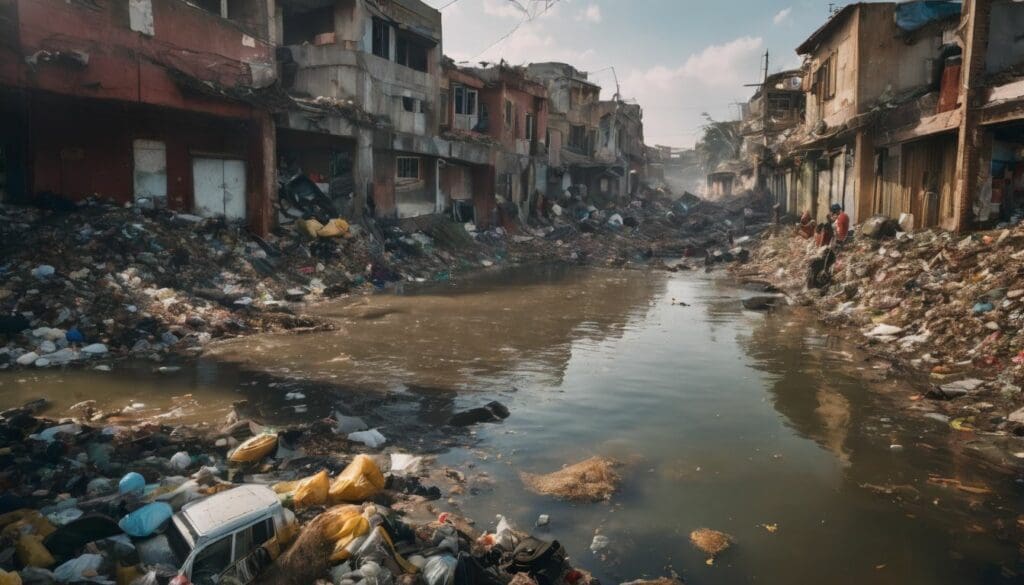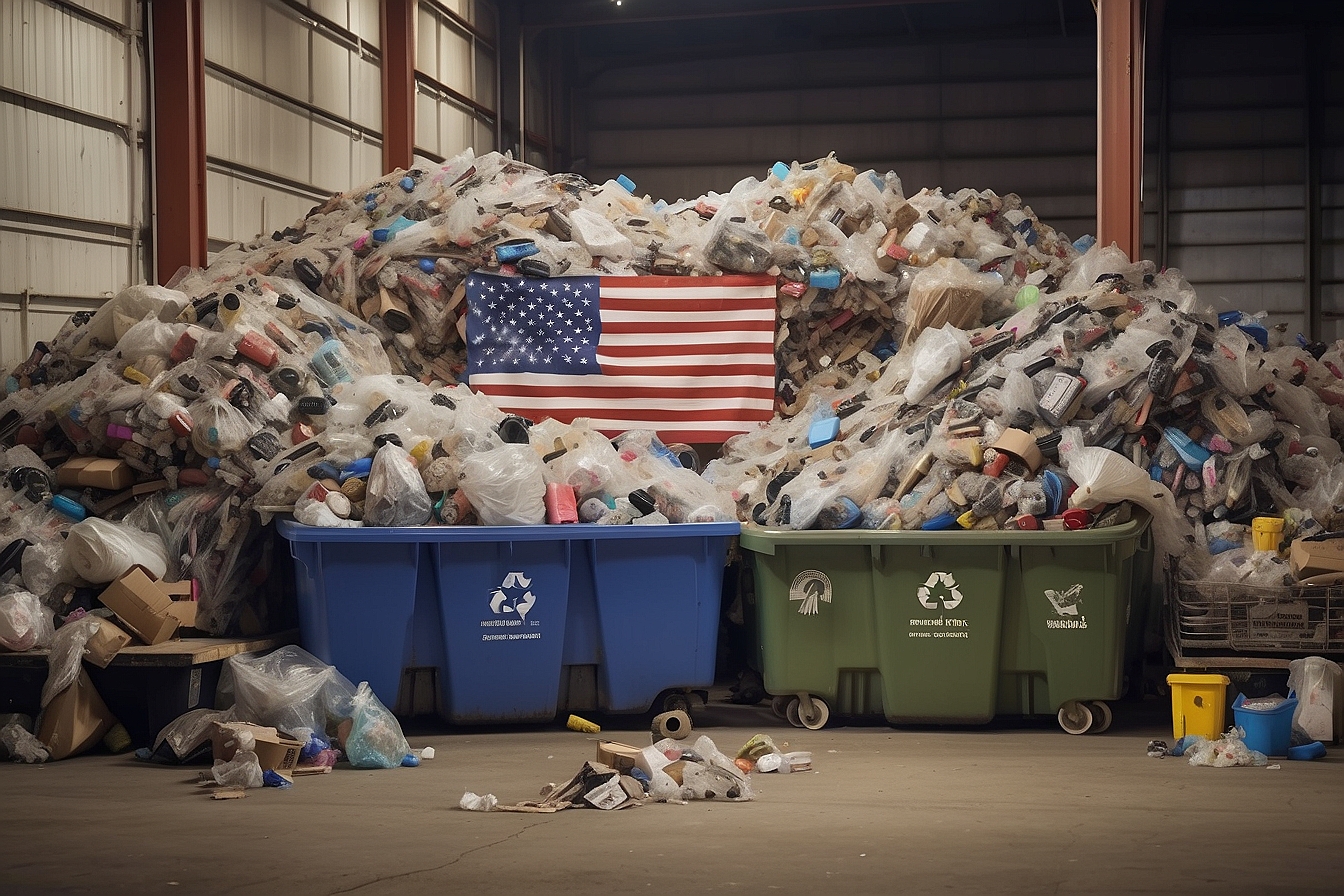The temptation of racks laden with the latest stylish attire, all at enticingly low prices, might be overwhelming. Yet this allure comes tethered to an unseen toll on our precious planet.
We’re not just fans of fashion here; we’re champions for the environment too. And alarmingly, it’s emerged that this very industry is churning out a staggering 10% of global carbon emissions.
In the following paragraphs, we shall take you on a journey through the often-overlooked costs of fast fashion — from its voracious appetite for water to wardsrobes’ worth ending up in heaving landfills.
Keep your eyes peeled as we peel back the layers to reveal how one can remain chic and eco-conscious – because truly, there’s no need to sacrifice style while saving our earth.
Key Takeaways
- Fast fashion is responsible for a massive 10% of global carbon emissions, highlighting the need for immediate action to reduce its impact on climate change.
- The industry not only pollutes our water with untreated dyes and chemicals but also contributes to microplastic pollution due to synthetic fibres from clothes entering our oceans.
- Urgently switching to slow fashion can help decrease waste and support ethical treatment of workers, promoting a sustainable future for both people and the planet.
Fast Fashion and Its Environmental Impact
Fast Fashion has a significant environmental impact, contributing to water pollution and waste, microplastic pollution, high energy consumption, and carbon emissions. These factors have a detrimental effect on our planet’s health and contribute to the climate crisis.
Water pollution and waste
In the fast-paced world of fashion, we’re witnessing a severe environmental cost. Our rivers and oceans bear the brunt as untreated dye waters from textile factories flow into them, bringing with them harmful chemicals and dyes.
These pollutants affect marine life disastrously and contaminate drinking water sources that communities rely on. The industry’s reliance on synthetic materials adds to this burden, as these non-biodegradable fibres break down slowly over time, leading to further contamination.
We also see an alarming amount of textile waste ending up in landfills every year. Clothes are discarded at a staggering rate due to constantly changing trends set by the fashion production cycle.
This contributes significantly to landfill pollution as many garments are not biodegradable or recyclable. We’re entangled in a web of wasteful practices, creating mountains of clothing rubbish with each passing season.
Sustainable fashion is not just a trend but an urgent call for change within our society and the environment we cherish.
Microplastic pollution
Transitioning from the water pollution and waste generated by fast fashion, we move on to another concerning issue: microplastic pollution. Synthetic fabrics such as polyester and nylon shed tiny plastic fibers when washed, ending up in water systems and oceans.
These microplastics harm marine life and can eventually enter the food chain, posing a risk to human health.
We can reduce microplastic pollution by choosing natural fibers like cotton or linen over synthetic ones, using a microplastic-capturing laundry bag, and supporting brands that use sustainable materials.
Energy consumption
The production of fast fashion involves high energy consumption at every stage, from manufacturing textiles to transportation and distribution. This process contributes significantly to the industry’s carbon footprint and overall environmental impact.
The use of fossil fuels in powering machinery, heating processes, and transporting garments all contribute to greenhouse gas emissions that accelerate climate change. Reducing energy consumption within the fashion industry is crucial for mitigating its environmental impact on our planet.
To combat this issue, sustainable practices such as using renewable energy sources, improving energy efficiency in manufacturing processes, and adopting circular economy principles are essential steps towards reducing the energy consumption associated with fast fashion production.
Carbon emissions
After discussing energy consumption in the fashion industry, it’s crucial to address carbon emissions. The production of fast fashion is a significant contributor to carbon emissions, releasing harmful greenhouse gases into the atmosphere.
From the manufacturing processes that rely on fossil fuels to transportation and distribution, every stage of clothing production adds to this environmental burden. As environmentally conscious individuals, it’s essential for us to be aware of the carbon footprint associated with our clothing choices and support sustainable alternatives.
While we advocate for eco-friendly fashion and slow fashion movements, reducing carbon emissions from the fashion industry requires collective efforts. Supporting brands that prioritise sustainable practices and minimising our own clothing consumption can significantly contribute to lowering carbon emissions in the textile industry.
The Social Impacts of Fast Fashion
Exploitation of workers in developing countries, poor working conditions, and human rights violations are all prevalent in the fast fashion industry, making it crucial to understand the social impacts behind our clothing.
Read more about how fast fashion affects society and the environment on our blog.
Exploitation of workers in developing countries
Workers in developing countries often face exploitation within the fast fashion industry. Unfair wages and long working hours are prevalent, impacting the lives of these individuals.
The focus on low production costs often leads to poor working conditions and a disregard for human rights, making it crucial for us to consider the ethical implications of our clothing choices.
It is essential for environmentally conscious individuals to recognise that the fashion industry’s impact extends beyond environmental concerns. Supporting conservation and sustainability also means advocating for fair labour practices globally.
Poor working conditions
Workers in the fast fashion industry endure unsafe workplaces, long hours, and low pay. Many garment workers toil in cramped spaces with inadequate ventilation and safety measures, leading to health issues and accidents.
They often face discrimination, harassment, and exploitation by employers. The lack of job security and limited access to healthcare or legal support further exacerbates their vulnerability.
These working conditions are not acceptable for anyone anywhere Keywords: worker exploitation, labor rights violation, garment industry work environment
Human rights violations
Moving on from the poor working conditions in the fashion industry, it’s important to acknowledge the human rights violations that often occur. Workers are frequently subjected to unfair wages, long hours, and hazardous working conditions.
Additionally, child labour is prevalent in many developing countries where fast fashion production takes place. These practices violate basic human rights and perpetuate a cycle of poverty for vulnerable individuals and communities.
It’s crucial for environmentally conscious consumers to support brands that prioritise fair labour practices and advocate for transparency within the supply chain.
Is Slow Fashion the Solution?
Slow fashion offers a sustainable and ethical alternative to the environmental and social impacts of fast fashion. By promoting conscious consumerism, reducing waste and pollution, and supporting fair labour practices, slow fashion aims to minimise the negative effects of the textile industry on the environment.
Promoting sustainable and ethical practices
- Using organic and biodegradable materials such as organic cotton, hemp, and bamboo to reduce the environmental impact of clothing production.
- Embracing recycling and upcycling techniques to minimise textile waste, decrease landfill pollution, and conserve resources.
- Investing in fair trade certifications to ensure that garment workers are compensated fairly and provided with safe working conditions.
- Collaborating with local artisans and craftspeople to support traditional craftsmanship, preserve cultural heritage, and promote sustainable livelihoods.
- Adopting transparent supply chains that allow consumers to trace the origins of their garments, ensuring accountability and ethical production practices throughout the entire manufacturing process.
- Partnering with environmental organisations to raise awareness about the importance of sustainable fashion choices, educating consumers about the environmental impact of fast fashion and promoting conscious consumerism.
- Engaging in sustainable design processes such as zero-waste pattern making, minimising fabric wastage during garment construction, and implementing innovative technologies that reduce energy consumption and water usage in manufacturing facilities.
Encouraging conscious consumerism
To encourage conscious consumerism, we should prioritise buying from sustainable and ethical fashion brands that emphasise eco-friendly practices. Checking clothing labels for organic or recycled materials can help us make informed choices, reducing the demand for environmentally damaging production methods.
By supporting companies committed to fair labour practices and reducing their carbon footprint, we actively contribute to a more sustainable fashion industry.
Additionally, educating ourselves about the environmental impact of fast fashion empowers us to make mindful purchasing decisions. Embracing minimalist lifestyles and opting for timeless pieces over trendy disposable items can significantly reduce our contribution to clothing production pollution and landfill waste.
Reducing waste and pollution
Encouraging conscious consumerism is a crucial step towards reducing waste and pollution in the fashion industry. By making mindful purchasing decisions, we can decrease the demand for fast fashion items that are often produced with little regard for their environmental impact.
Opting for eco-friendly and sustainable clothing not only minimises waste but also reduces the pollution caused by the manufacturing process.
Choosing to support brands that prioritise ethical and sustainable practices will push the industry towards adopting more environmentally friendly production methods. This shift will ultimately lead to a significant reduction in the overall environmental cost of fast fashion, positively impacting our planet’s health and sustainability.
Supporting fair labor practices
We believe in supporting fair labour practices within the fashion industry to ensure that garment workers receive fair wages and work in safe conditions. This is crucial for promoting ethical and sustainable fashion.
- Ensuring fair wages: Garment workers should receive fair compensation for their labour, allowing them to support themselves and their families adequately.
- Providing safe working environments: Workers must be guaranteed a safe and healthy workplace, free from exploitation or hazardous conditions.
- Respecting worker rights: Upholding the rights of garment workers, including the freedom to unionise and advocate for better working conditions, is essential for a sustainable and ethical fashion industry.
- Promoting transparency: Fashion brands should be transparent about their supply chain practices, ensuring that every worker involved in production is treated fairly.
- Partnering with certified ethical suppliers: Collaboration with suppliers who adhere to fair labour standards helps to promote positive change within the industry.
- Empowering workers: Encouraging empowerment through education and skill development initiatives can improve the lives of garment workers in developing countries.
Conclusion
In summary, fast fashion exacts a heavy toll on our environment. It contaminates water sources and produces vast amounts of waste, contributing to pollution. Additionally, it consumes excessive energy and emits high levels of carbon dioxide.
Taking steps towards sustainable and ethical practices is crucial in mitigating these environmental impacts. By promoting conscious consumerism and supporting fair labor practices, we can move towards a more eco-friendly fashion industry.
FAQs
1. What is the environmental cost of fast fashion?
The environmental cost of fast fashion includes the significant pollution and negative impact that the textile industry has on our planet, harming both ecosystems and communities.
2. How does clothing contribute to environmental pollution?
Clothing contributes to environmental pollution through waste from discarded garments and toxic chemicals used in manufacturing, which damage soil, water, and air quality.
3. Can fashion be eco-friendly?
Yes, sustainability in fashion is possible when we opt for ecofriendly materials, support ethical brands committed to reducing their environmental footprint, and practice conscious consumerism.
4. Why should we care about the impact of the fashion industry on the environment?
We should care because the fashion industry’s pollution affects wildlife habitats and human health; by choosing sustainable options, we can help reduce these detrimental effects on our environment.





